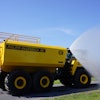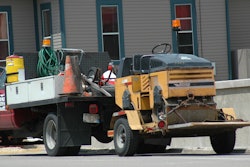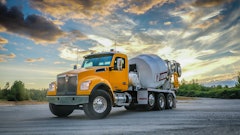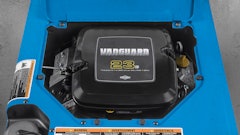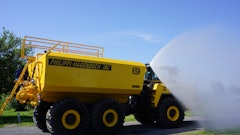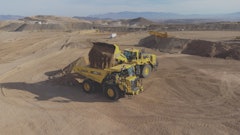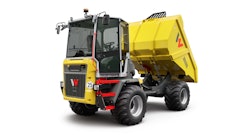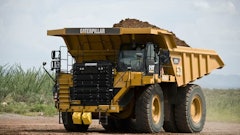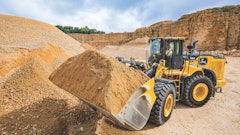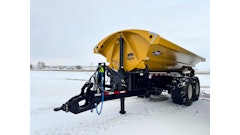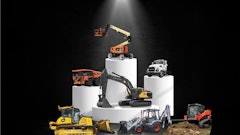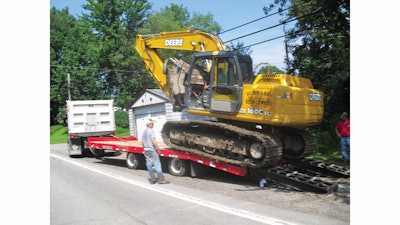
Dump trucks have unique towing considerations.
“The entire vehicle/trailer combination must be considered before towing, including gross combined weight, trailer weight and the towing capacity of the pintle hook and supporting crossmember,” says Stu Russoli, vocational market manager, Mack Trucks. “In addition, brakes, axles, the transmission and other components must be evaluated to ensure they are rated for the weight being towed.
“Towing impacts virtually all aspects of the dump truck and components,” says Russoli. “When spec’ing a truck, the gross trailer weight to be towed and the trailer tongue height should be taken into account for a robust rear crossmember design. This design structure should not be modified by a dump body builder to accommodate the dump pivot structure. Ideally, the dump pivot design should be integrated into the rear crossmember design for a pintle hook type of rear crossmember.”
Western Star emphasizes the importance of communicating with the body upfitter. “Often the body builder installing the dump body will install the towing equipment because they are modifying the rear crossmember to fit the dump pivot,” says Anthony Nigro, application engineering manager. “It’s important to consider the vertical height of the towing equipment. Ensure the trailer you are hauling mates up to the coupling on the truck at the proper height. This is usually done by specifying any height requirements that you might have at the time of order, and is spec’d as minimum unladen height.”
There are differences between spec’ing dump trucks and light-duty trucks for towing applications. “Rear axle capacity is not usually a limit to trailer choice,” says Russoli. “The gross trailer weight and tongue weight are common factors that are limited by crossmember design and the dump truck frame rail thickness. Other truck components must be evaluated for towing to ensure they are capable of handling the load, including the transmissions, prop shafts, cooling system, etc.”
Suspensions should provide the necessary stability. “You should consider suspensions with limited side sway and lower centers of gravity,” says Mary Aufdemberg, director of product marketing, Freightliner Trucks. “A very important thing to remember when ordering your new dump truck is to order air and electrical connections at the end of the frame. This is a fairly inexpensive item at time of order, but very inconvenient and costly when you have to retrofit the truck.”
Make sure the rear axle is up to the task. “There are many types of trailers used in construction,” says Nigro. “Whether you are hauling a pup or a small equipment trailer, the rear axle plays an important role in determining towing capacity. Any towing weight is part of your gross combination weight (GCWR), and rear axles must be properly sized to handle the additional weight. It is important for the customer to understand legal axle loads in that area and whether the towing will happen while the truck body is loaded or only empty.”
Choosing the right size trailer for the job is one of the potential pitfalls. You need to consider both the size and weight capacity for the equipment you will haul. The gross vehicle weight rating (GVWR) minus the trailer’s empty weight gives you the trailer’s payload (weight) capacity. You may want to consider a trailer that has a capacity 10% to 20% above the actual equipment weight. This will allow a safety margin if you ever want to throw another bucket or attachments on the trailer. In addition, if the equipment is full of mud, that will add weight, as well.
Weight distribution is also important when choosing a trailer. The weight distribution has a huge effect on how the trailer pulls and stops. Weight distribution affects how much weight is transferred to the tow vehicle and the resulting load on the axles.
Legal Weight Restrictions
Often, the dump truck is physically able to tow more than is legally permissible. One of the hurdles is the axle spacing, which is typically close together when pulling a tag trailer with a dump truck.
“Federal, state and provincial laws dictate the configuration of the axle spacing,” says Russoli. “It is critical to refer to these laws when towing with a dump truck.”
Weight regulations vary by state. Make sure you understand the regulations of the state in which you are operating. The limits are often defined by the number of axles and the axle spacing. The dump truck will be subject to a gross combined weight rating (GCWR). This may be the limiting factor more times than trailer capacity.
“Weight per axle is typically the most common limitation by state and federal regulations on weight per axle and total length between axles for bridge safety,” says Aufdemberg. “Drawbar length is a factor in axle spacing between the truck and trailer and overall length.”
Whether you only plan to tow when the dump truck is empty is another variable. “The payload of a dump truck affects available towing capacity because it affects the total gross combined weight of the truck and trailer,” says Russoli. “If the ability of the truck to ascend grades is impacted, the trailer weight needs to be reduced. Legal restrictions on weight must also be considered.”
The largest typical load allowable behind a 10-wheel dump truck is 42,000 lbs. Federal regulations only allow 42,000 lbs. on a three-axle group with a 49-in. spread configuration. In addition, the weight of the truck and trailer added to the cargo may not exceed 80,000 lbs. The ability to haul 42,000 lbs. is also based on the weight distribution of the cargo. It needs to be situated to distribute enough weight to the tongue to equal the empty weight of the trailer. If not enough weight is transferred to the axle, the weight will exceed the allowable federal weight limit.
Another limitation is often the capacity of the pintle hitch. Heavy-duty pintle hooks normally have a 15,000-lb. vertical load limit and a 25-ton tow rating.
But that can vary by the type of towing device selected. “The type of towing device is also determined by the type of trailer you are hauling,” says Nigro. “You can select from a full range of couplings/pintle hitches to tow hooks and tow pins that will best suit the requirements of your application.”
The length of the hitch is also important. Consider how much overhang there is between the pintle hitch and the end of the dump box. You must have enough swing clearance to accommodate that overhang. A longer overhang would require a longer hitch.
Conversely, locating the hitch as close to the rear axle as possible keeps the load on the hitch from reducing weight on the front axle. You really need to carefully consider the weight distribution.
Some loads can prove more challenging. If you have a larger excavator, it needs to have the counterweight over the hitch to get the boom low enough. This makes the weight on the hitch very heavy.
Calculate Capacity
The GVWR listed on a trailer is the maximum a trailer should ever weigh when loaded. A trailer manufacturer may give you a GVWR of 100,000 lbs. (50 tons), but you need to subtract the trailer weight. A 50-ton trailer can weigh anywhere from 18,000 to 20,000 lbs. That gives you an actual carrying capacity of 40 tons.
If a trailer weighs 10,000 lbs. and the GVWR (found on the hitch) is 40,000 lbs. that means you can put 30,000 lbs. of payload on the trailer, assuming all other components are spec’d accordingly.
The gross axle weight rating (GAWR) is also listed on the trailer’s certification label. According to the Trailer Safety Industry Coalition (TSIC), this indicates the most weight an axle can bear. If the trailer has more than one axle, each axle will have weight rating information provided on the certification label.
The best way to avoid overloading a trailer is to know the weight of what is being loaded. Be sure to take the total weight of fuel and attachments into account.
“Each trailer should have its tongue weight recorded,” says Russoli. “That weight should be used to determine the ‘off-loading’ effect on the front axle of the dump truck serving as the tow. It’s best to crunch the numbers and make sure none of your truck’s component ratings or legal limits are exceeded.”
“Best practice, due to variances in loads, is to weigh the tongue of the drawbar eye when the trailer is loaded to GVWR and add a factor of safety,” says Aufdemberg.
“In general, the weakest component will limit the weight you can safely tow,” notes Russoli. “The structural capacity of the ‘towing system’ (frame rails, crossmember, pintle, local reinforcements, safety chain attachments) must be rated strong enough to resist the tongue weight and the fore-aft trailer loads during hauling. Towing systems are tested to verify strength using a standardized test method for the intended towed trailer weight (SAE J847).
Work with Your Dealer
Dealers can ensure the truck is set up properly to handle the trailer and anticipated loads.
“When it comes to ordering a new truck, it is important to first let your dealer know the intended use of the truck,” says Nigro. “Western Star dealers then work in tandem with our Custom Application Engineering group to understand each customers’ work environment to spec the truck to their exact needs.”
A dealer understands what can and cannot be done. “The No. 1 priority is safety,” says Aufdemberg. “Always work with a salesperson that has experience with specifying the proper equipment. It is vital that they understand the application and select the right equipment for items such as the hitch and drawbars.”



